Visual arts
What the local art collections are for
This selection of 10 paintings, chosen from the Kirklees Art Collections, were co-curated by Janine Sykes (Visual Arts Curator, Kirklees Museums and Galleries) and Megan Hickes (Exhibitions Curator, Craven Museum & Gallery). They explore the connection between collections and health.
The original Huddersfield Library and Art Gallery was founded in 1898 by the County Borough of Huddersfield. It initially held exhibitions of loans from local collectors and the work of members of the Huddersfield Art Society (formed in 1890).
In 1940 a purpose built library and art gallery was completed, designed by the architect E.H. Ashburner. The building opened in the midst of World War II so the floor set aside for the gallery was instead used as an emergency hospital. It was not until 1943 that the gallery opened in this building. During the war years, the gallery hosted a number of small manageable exhibitions but it wasn't until after the war that the gallery was officially launched.
The grand original opening exhibition which was scheduled to coincide with the opening of the building finally took place in 1946. Titled 'Two Hundred Years of British Art' it brought together works from public and private collections and was a comprehensive survey of British Art with works by Turner, Constable, Stubbs, Hogarth and Gainsborough. The exhibition was opened by Kenneth Clark, the art historian and director of the National Gallery.
Up until 2020, the grand building was home to the Kirklees art collections which was formed in 1974 as a result of local government reorganisation, which brought together the museum and art gallery collections of Huddersfield, Dewsbury, Batley and a number of small authorities and town councils that constituted Kirklees Metropolitan Council.
The Huddersfield Art Gallery permanent collection includes paintings, works on paper and sculptures by internationally renowned artists such as Francis Bacon, L.S. Lowry and Henry Moore.
What to expect in the box
- Medium: Oil on canvas
- Measurements: H 92 x W 92 cm
- Date: Not provided
Tony Noble (b.1958) is an artist living and working in Batley, West Yorkshire.
He worked as a school teacher for almost 30 years, and decided to follow his passion to become a full-time artist in 2008.
He has said that he likes to draw and paint studies from life, including references to their lives and their interests.
When asked why art is important to society, he said "it helps us to recognise our similarities and our differences, and to sometimes celebrate or question the wonderful, the beautiful, the fantastic, the awful".
The painting by Noble, depicting local children surrounded by art helps us think about what the (social, health and educational) benefits of art could be.
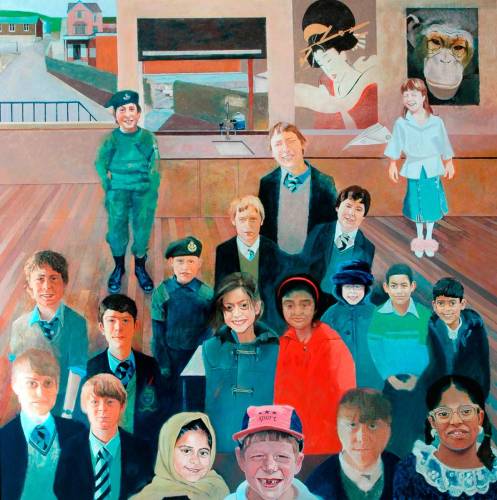
- Medium: Oil on canvas
- Measurements: H 61 x W 65 cm
- Date: 1927
This portrait of Harry Roebuck opens a story of Huddersfield-born collector and amateur artist Clement Roebuck who gifted this oil painting to Kirklees in 1977.
As well as commissioning works, C. Roebuck sat on the Huddersfield Art Gallery committee and often purchased the works he thought should be part of the collection.
In 1988 C. Roebuck bequeathed 145 pieces of his art collection 'to the people of Skipton', as he had lived nearby. To this day you will always find a portion of the Roebuck collection on display at Skipton Gallery.
Harry Roebuck went on to build The Roebuck Memorial Homes, in Huddersfield. In memory of his son and wife.
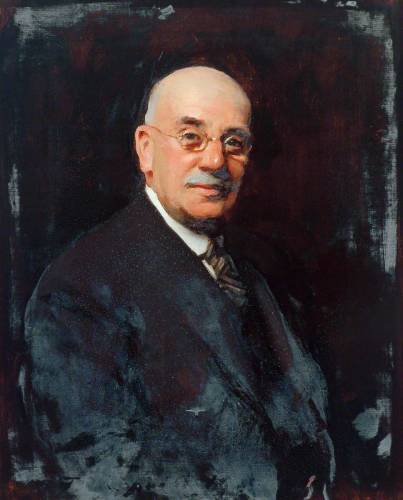
- Medium: Oil on board
- Measurements: H 114 x W 88 cm
- Date: Late 20th century
This late 20th century oil painting was commissioned by Wakefield Public Arts. This painting depicts Batley and the intergenerational figures that make a community - in vibrant colour, against a backdrop of branding and a distinctly Batley townscape.
David Prudhoe has often been described as a socialist painter, and his work often highlights the people and places of industrial towns.
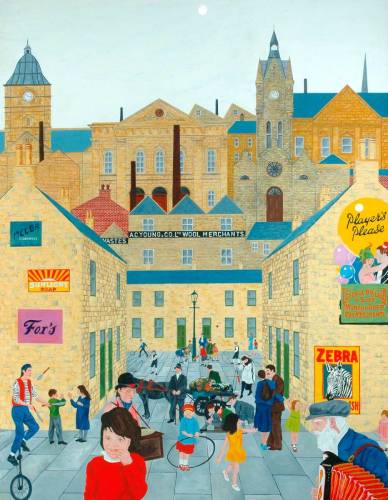
- Medium: Oil on board
- Measurements: H 45.5 x W 56.2 cm
- Date: 1975
This painting is very animated, with gestures and debate within the blue-collar figures of blue-collar, against the backdrop of industrial Huddersfield/Dewsbury or Batley.
This was painted in the mid-seventies at the height of union mobilisation. This work helps us reflect of what changes can be achieved when people work together.
Harold Blackburn (1899-1980) was a painter from Huddersfield.
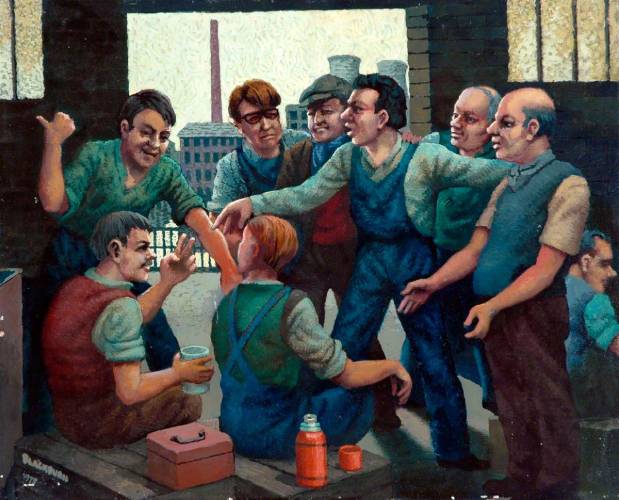
- Medium: Oil on board
- Measurements: H 45.8 x W 61.2 cm
- Date: 1974
Harold Blackburn (1899-1980) was a painter from Huddersfield.
The work shows a bustling Huddersfield Piazza, depicting the civic architecture, including the Town Hall and entrance to Huddersfield Art Gallery and Library.
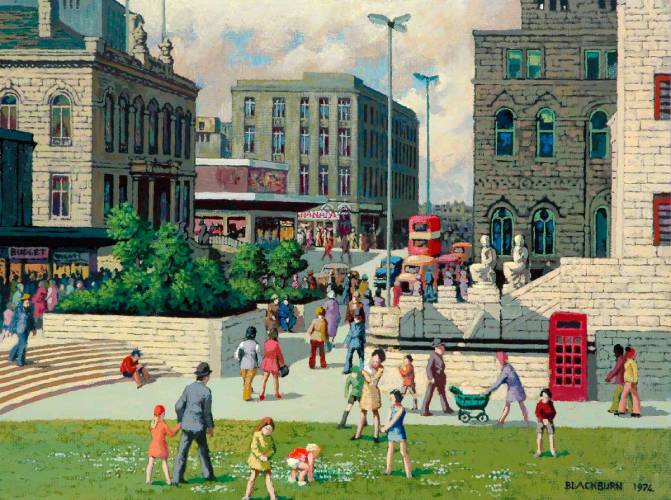
- Medium: Oil on canvas
- Measurements: H 135 x W 241 cm
- Date: 1939
This painting is one of a series of five 'murals' commissioned by the former County Borough of Huddersfield at a cost of £50 to decorate the children's department of the new Central Library.
They were commissioned from Charles Reginald Napier (1910-89) who was the first assistant master at the Huddersfield Technical College.
Napier worked with six of his students on the commission which were completed between 1938 and 1940.
Each picture depicts a story typical of traditional folk tales often told in one village at the expense of another. The central panel, Telling of the Stories, depicts an old man in the village telling his friends some of the legends of the district.
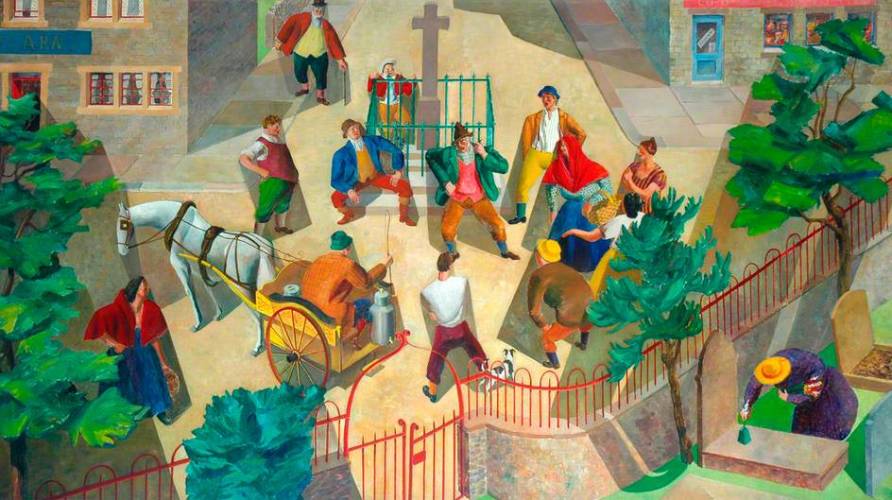
- Medium: Oil on panel
- Measurements: H 60 x W 49 cm
- Date: Mid-20th century
'Ripon Market' reminds us of the importance of market culture in the region (past and present).
Ripon's market has been at the center of city life since at least the 11th century, with some sources dating it back to the 10th century.
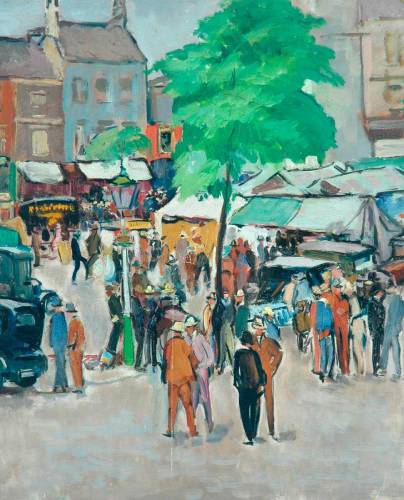
- Medium: Oil on board
- Measurements: H 35.5 x W 44.5 cm
- Date: c. 1960
This painting reveals a narrative about a successful career in art education nurtured in the region.
This figurative street scene by Gerald Park (b.1937) has a beautiful colour palette, informed by an acute sense of perspective and form.
Park was born in Cleckheaton and studied at Batley, Liverpool, and The Slade (schools of art) in the fifties. Our records show he went on to become a visiting Professor at University of Wisconsin in the US.

- Medium: Tempera on paper
- Measurements: H 46.8 x W 31 cm
- Date: Not provided
This painting shows the townscape of Dewsbury, dominated by a large Shoddy Mill, which after redevelopment is now reused as flats.
Noël Spencer (1900 - 1986) was a printmaker and artist, born in Warwickshire. He held a number of teaching positions, notably principal of Norwich School of Art 1946-64.
Spencer was interested in depicting townscapes and landscapes, a notable achievement in the 1940s being many pen drawings of Huddersfield, completed while he was head of the Art School there.
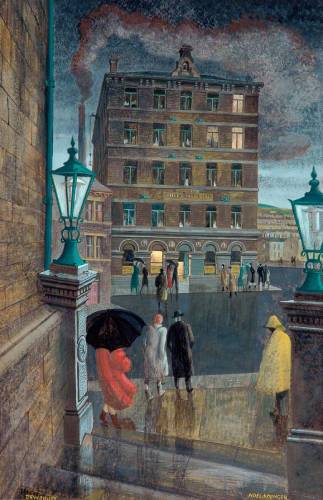
- Medium: Oil on canvas
- Measurements: H 67.5 x W 86.5 cm
- Date: 1903
Joseph Pinder was the last of the Kilpin Hill handloom weavers in Spen Valley.
The weavers' cottages had a loom chamber and scouring place, while outside, tenter frames for drying the finished cloth were on nearby land. This allowed them to weave blankets from home.
By 1850, mechanisation had led to a decline in handloom weavers. However, the Kilpin Hill weavers continued to work, and Joseph continued as a weaver until his death in 1910.
His cottage was 39 Kilpin Hill Lane Heckmondwike, which is now used as a garage.
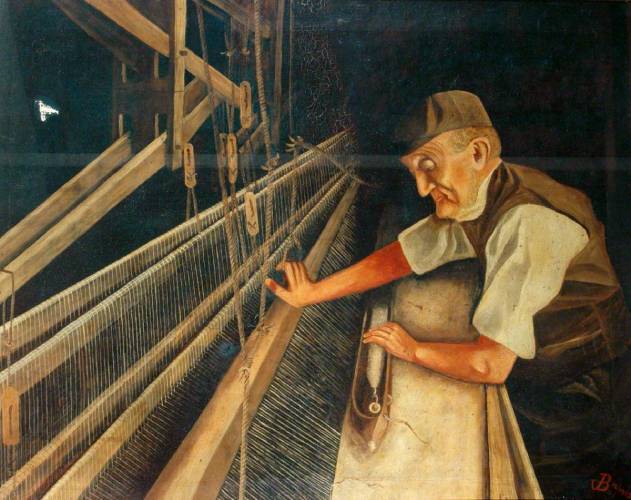
Explore the following themes using the objects
- Childhood
- School
- Jobs
- Landscape
- Politics
- Leisure
- Industry
- Textiles
- Identity
- Community




